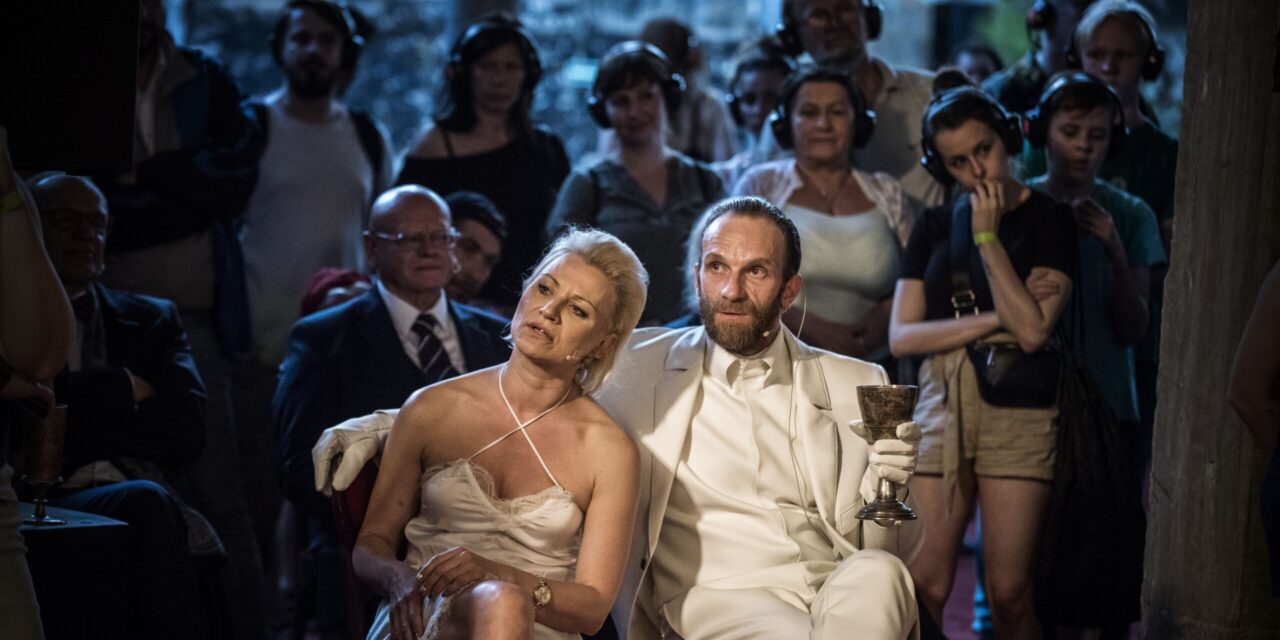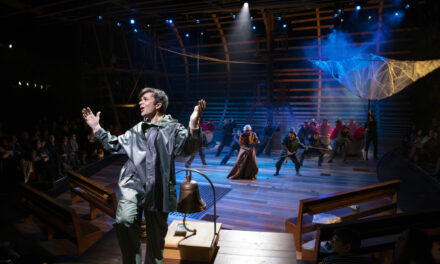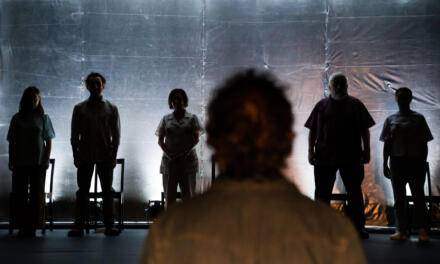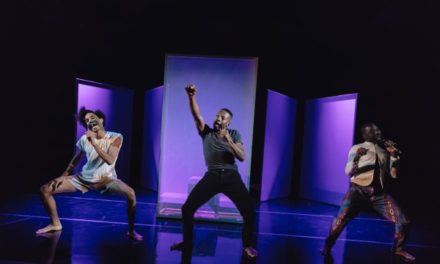What is the role today of one of the pivotal narratives of Western culture, William Shakespeare’s Hamlet? Does it really serve the functions it has been claimed to serve, providing a narrative frame for our existential quandaries, unconscious desires and deeply hidden assumptions about how the world is and should be arranged? Or is Elsinore merely a historic relic, a tired, hollow word? Or perhaps, as Walter Benjamin contends, there is no longer any story capable of capturing the experience of our era ‒ all we have are bits and pieces we are unable to put together (Benjamin, 1996). All these possibilities, and more, are on offer in Maja Kleczewska’s Hamlet mounted at Poznań’s Old Slaughterhouse (Stara Rzeźnia).
In order to grasp the tensions playing out in the show, we first need to establish how the director builds her artistic statement. The very fact of setting Hamlet in a non-theatre building slated for rehabilitation by a private developer suggests we are not in for a traditional revival. As envisaged by stage designer Zbigniew Libera, the floor and walls of the Old Slaughterhouse are covered with red carpets. The action unfolds simultaneously in multiple places. The royal bedroom is located in the corner of the main room while the dining area with a huge table has been set up in another space. On entering, you are met by a small orchestra under the baton of Adam Domurat. Before the show kicks off, wireless headphones are handed out to the audience who can choose from three channels relaying live audio from simultaneously running scenes. This might suggest the show will be very unlike a traditional theatre experience. The programme notes say that it is more of a gallery opening than a theatre performance.
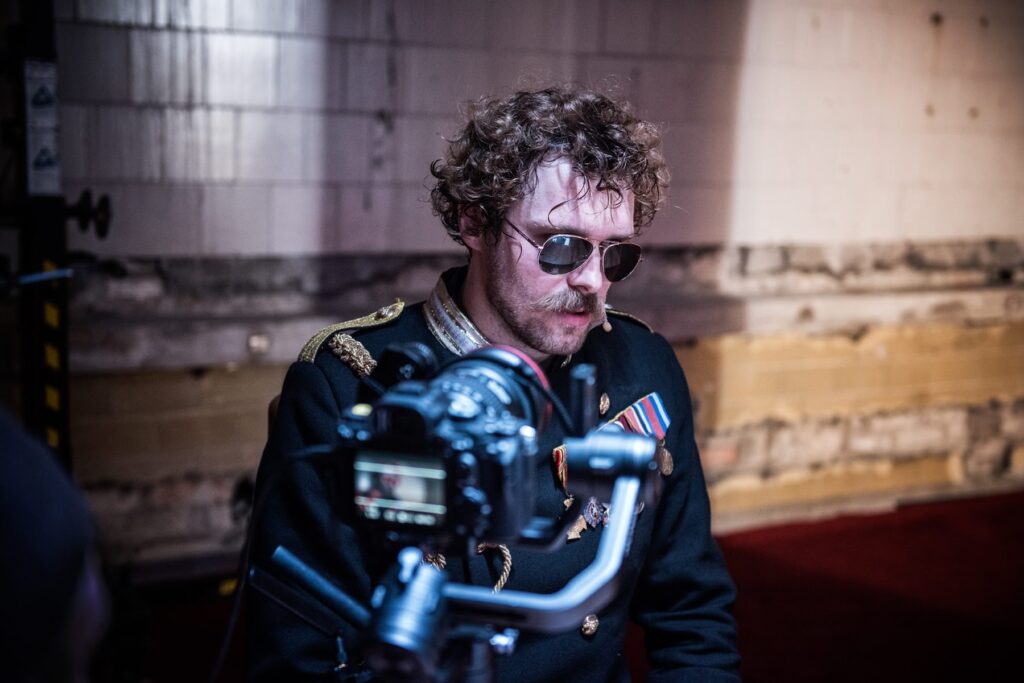
Photo by Magda Hueckel. Hamlet/Гамлет, directed by Maja Kleczewska, Polish Theatre in Poznan, Poland, 2019. Image courtesy of Polish Theatre in Poznan.
Nothing could be further from the truth ‒ one can easily watch Kleczewska’s Hamlet from beginning to end, following Stanisław Barańczak’s Polish translation scene by scene. When the drama’s key events play out, the simultaneous action is put on hold, and the three channels converge into one. The audience can move freely around the building, but they tend to congregate where the action is taking place. Another thing that makes it easier to follow the plot are the fully embodied characters that are the staple of traditional dramatic theatre rather than more experimental fare. Roman Lutsky’s Hamlet, though, strays far from the conventional figure of a vulnerable young man assailed by doubts. In his portrayal, the traits customarily attributed to the Shakespearean character are distorted and degenerated. His Prince of Denmark is psychotic and irascible, and hence dangerous. The Ukrainian actor exudes an aura of corruption ‒ his Hamlet has gone too far into insanity, making his motivations hard to grasp. The violent relationship between him and the wheelchair-bound Horatio made up to look like Stephen Hawking (Michał Sikorski) seems to defy all meaning and logic. Hamlet keeps on abusing the cripple, even forcing him to say, or, more precisely, ‘dribble out,’ his famous soliloquy. To Kleczewska, it appears, ‘To be, or not to be’ is a sick joke: it offers no room for inner conflicts, there is nothing but steady decline.
Darkness seems to lurk at every turn in Poznań’s Hamlet. Gertrude (Alona Szostak) tries to ward it off by maintaining a constant level of alcohol in her vascular system. Yet, now and again, it becomes clear that her drunken laughter is a cover for a feeling of terror and a psyche ravaged by extreme emotions. Claudius (Michał Kaleta) is the only character who remains unruffled whatever happens. Even the play put on by Hamlet doesn’t throw the king off his stride ‒ he sees it as a joke rather than an accusation. Ophelia (Teresa Kwiatkowska) is a different sort of character who seems lifted from a Krzysztof Warlikowski production. Rather than having a clearly-defined character profile, Hamlet’s beloved is a mosaic of quotations. Her white dress and blonde hair readily evoke Marilyn Monroe; her ‘I love you’ sash is an obvious nod to beauty pageants. What matters here is not so much the references but the emptiness they conceal. Ophelia is emblematic of the story’s escalating degeneration. She is more akin to the woman with her head in the gas stove in Hamletmachine than to the fragile figure in John Everett Millais’ canvas.
The opening piece of music, whose lyrics are based on Heiner Müller’s Hamletmachine, chimes in with the degenerate and depraved characters. As the fierce tune booms in the background, the choir belts out: ‘I was Hamlet. I stood on the shore and spoke BLAH BLAH BLAH to the breakers, behind me the ruins of Europe.’ ‘BLAH BLAH BLAH’ is repeated several times and blends together with ‘I was Hamlet’ spoken simultaneously by multiple actors. Past tense is the operative word here ‒ there is no Hamlet at the Old Slaughterhouse but what’s left of it, gobbledygook. Kleczewska’s Hamlet is a corpse that keeps coming back to life. The play’s text is delivered almost in full, and the action unfolds in line with the events described in the play, but this only goes to show that the time of the greatest tragedy is over. This diagnosis is most starkly evident in the degeneration of the characters, whose motives seem impossible to read. The protagonists’ actions are in sync with the escalating corruption culminating in the scene of Polonius’ murder and ending with an incest attempt initiated by the protagonist. The acting is high-key, but it is hard to take the scene at face value. Mumbling words in a foreign language, Szostak appears more pathetic than shocking, and we can reasonably expect that this is what the director intended.
Time and again, Kleczewska goes one step too far, raising the question, not whether it is possible to interpret Shakespeare’s tragedy, but whether one should even try. Of course, it would be equally justified to view such attempts as evidence of a failed production, one that aspires to psychological depth or intensity but is in fact a pretentious, unpalatable, meaningless mush. Some circumstantial evidence might suggest that the former option is more likely.
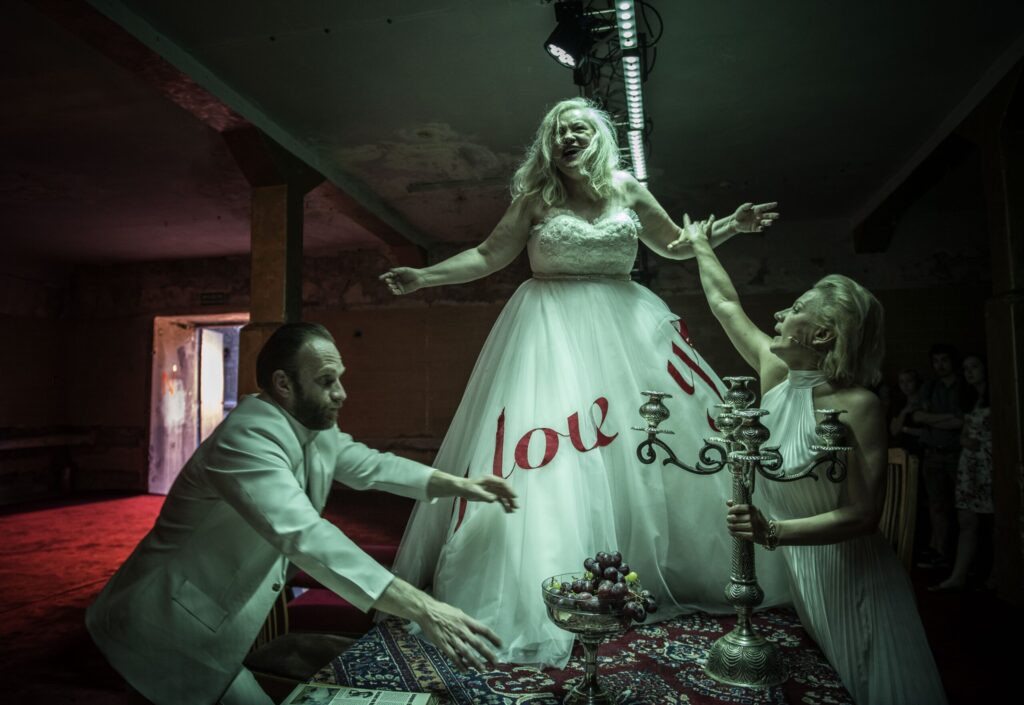
Photo by Magda Hueckel. Hamlet/Гамлет, directed by Maja Kleczewska, Polish Theatre in Poznan, Poland, 2019. Image courtesy of Polish Theatre in Poznan.
Other than the Ukrainians, there are three other artists from minority ethnic backgrounds: Gamou Fall, Flaunnette Mafa and Mandar Purandare. For most of the show, they circulate among the audience, keep in the background, say nothing, often get out of the building. All this changes in the finale, when those whom the playwright wanted to die have already breathed their last. Purandare enters the main space, breaks into a dance and chants an Indian song as he negotiates his way among the corpses. After a short while, he is joined by Fall, his face adorned with feathers, whose dance has a distinctly African flavour. Finally, there is Mafa, who exclaims: ‘I have a right to this land!’ But does she really? This declaration ‒ extremely potent, it might seem ‒ takes on a rather pathetic ring when the audience realizes that the ethnic actors play only bit parts, staying in the shadows of the whites most of the time. What’s more, when Fall, Mafa and Purandare finally become active onstage, their actions are somewhat exotic and embarrassingly stereotypical, making the creators’ take on multiculturalism a charade rather than an emancipatory project. It would seem that Kleczewska and the dramaturg Łukasz Chotkowski buckled under the weight of their ambition and just didn’t pull it off this time.
There is another possibility, though, if we consider the meaning of the reminder of the piece and the contexts of Shakespeare’s play. What is the true place of actors of different origin and colour in the drama? To be sure, there is no shortage of productions where some or even all actors are people of colour, but it is doubtful whether the fact of casting them in revivals of an essential Western tragedy represents a triumph of emancipation.
In her famed essay, ‘Can the Subaltern Speak?’, Gayatri Chakravorty Spivak demonstrates how the Western intellectual tradition denies a voice to the subaltern other by exploring other cultures through the lens of universal concepts (such as subject). It does so not only because Western knowledge and scientific language support the power structures and relations that ‘produced’ the problem of global inequality, but also because the issue of otherness can only be addressed in the framework of Western discourse. Even if we stay silent, the subaltern will not be able to speak ‒ the only available way of speaking of their oppression, paradoxically, makes it impossible. To put it another way: as soon as you even begin tackling the problem of otherness, you contribute to propagating it.
This is why the unequal distribution of roles in Kleczewska’s piece may be seen as irrelevant. The same goes for the exotic dances and songs in the finale. Any other strategy would ultimately mean a fiasco. The only solution seems to be to focus our attention on this specific result of the exploration of multiculturalism and the power relations it involves. Perhaps this is what Kleczewska does. The show’s rather unusual resolution seems to corroborate this reading. When the ritualistic dances and chants come to an end, the corpses rise up and the actors slowly make their way to where they stood when the show began. In the meantime, the crowd waiting for the second performance of the night is let into the building and can see the finale of the show before its beginning. The mumbling living dead begin to chant the opening piece. Before you know it, the show restarts.
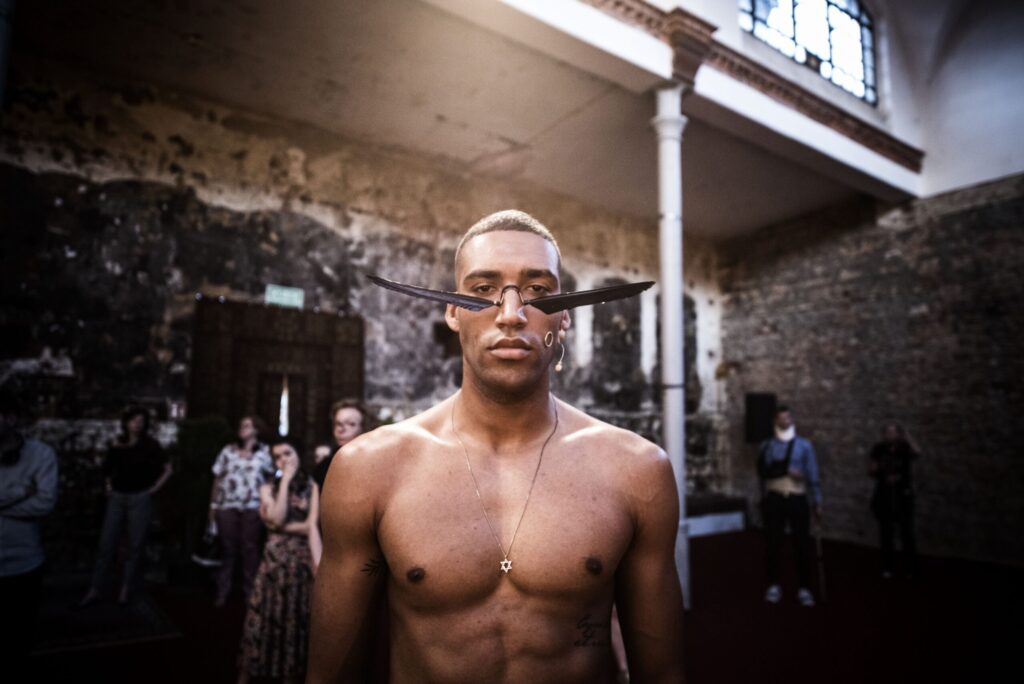
Photo by Magda Hueckel. Hamlet/Гамлет, directed by Maja Kleczewska, Polish Theatre in Poznan, Poland, 2019. Image courtesy of Polish Theatre in Poznan.
Flaunnette Mafa’s fiery pledge was completely in vain ‒ the other is denied a voice, even when she starts speaking. In the meantime, Hamlet ‒ one of the most seminal Western narratives ‒ will be retold again, the cadaver of the text will keep on rotting, but will never fully decompose. However hard directors might try, Shakespeare cannot be decolonized; at best, we can speak of fatigue produced by multiple attempts to create a multicultural theatre, which have repeatedly failed because the tragedy is steeped in oppressive structures. To be sure, I don’t want to accuse Shakespeare’s text of racism lurking between the lines ‒ even if it were there, it would be irrelevant ‒ but rather point out that Hamlet belongs to the Western (hence hegemonic) episteme, and so it is told within the linguistic and cultural framework upholding inequality. No matter who ponders ‘To be, or not to be,’ this first of all serves to perpetuate a particularly structured culture, including its relations with other cultures. Kleczewska seems to be saying: ‘Enough of Hamlet,’ but rushes to add: ‘Hamlet will last.’ And it will remain the same, regardless of what we do with it.
If Kleczewska’s audience finds this reading to be far-fetched, I can’t help but agree. What her Hamlet does is rather conjure doubt than try to convey a message. The unusual solution of having two shows overlap, which suggests a recurring issue, is a rather flimsy premise for salvaging this problematic show. Besides, the linear action, which is surprising in view of modern theatre practice, and the tiresome, traditionally built roles do not make this Hamlet a pleasure to watch. I present the above reading not so much in defence of the piece but because I fear that the alternative would be to admit that Kleczewska has helmed an ill-considered, harmful production underpinned by flagrantly superficial diagnoses and subconscious prejudices.
References
Benjamin, Walter, ‘Narrator. Rozważania o twórczości Mikołaja Leskowa,’ translated by K. Krzemieniowa, in Walter Benjamin, Anioł historii. Eseje, szkice, fragmenty, selected and edited by H. Orłowski, translated by H. Orłowski et al, Wydawnictwo Poznańskie, Poznań, 1996.
Müller, Heiner, Hamletmachine and Other Texts for the Stage, translated by Carl Weber, New York, Performing Arts Journal Publications, 1984.
Spivak, Gayatri Chakravorty, ‘Can the Subaltern Speak?’, https://jan.ucc.nau.edu/~sj6/Spivak%20CanTheSubalternSpeak.pdf, last accessed on 17 April 2020.
Hamlet/Гамлет, Polish Theatre, Poznań
directed by Maja Kleczewska; dramaturgy by Łukasz Chotkowski; theatre script by Maja Kleczewska and Łukasz Chotkowski; stage design by Zbigniew Libera; lighting and cinematography by Marcin Koszałka; costumes by Konrad Parol; music by Cezary Duchnowski; music supervision by Adam Domurat; choreography by Kaya Kołodziejczyk. Premiered on 7 June 2019.
This article was originally published in Polish by Didaskalia. Theater Journal 2019, no. 153. It was translated into English by Didaskalia and TheTheatreTimes.com and reposted with permission. The translation was supported by Polonia Aid Foundation Trust.
Didaskalia is now an open-access journal. The frequency remains unchanged and they will continue to appear bimonthly.
This post was written by the author in their personal capacity.The opinions expressed in this article are the author’s own and do not reflect the view of The Theatre Times, their staff or collaborators.
This post was written by Witold Loska.
The views expressed here belong to the author and do not necessarily reflect our views and opinions.

